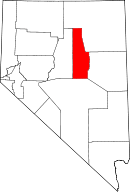Ruby Hill, Nevada
| Ruby Hill | |
| Ghost town | |
| Remains of Ruby Hill, Nevada | |
| Official name: Ruby Hill | |
| Country | United States |
|---|---|
| State | Nevada |
| County | Eureka |
Ruby Hill is now a ghost town in Eureka County, in the central part of the U.S. state of Nevada, approximately 2.6 mi (4.2 km) west of the town of Eureka, Nevada. In 1910, the town was destroyed by a powerful storm that washed away the railroad and other buildings and left the town uninhabitable.[1]
History
In 1865, an Indian showed a piece of "mineral-bearing" rock to Owen Farell, M. G. Cough, and Alonzo Monroe. The men looked at the rock and immediately recognized that there might be more rocks just like that one. For ten dollars, they talked the Indian into showing them where he had found the rock. Upon payment, the Indian directed them to a spot about two and a half miles west of the township of Eureka, Nevada.[2] On this site, the northwestern side of Prospect Mountain, the Buckeye and Champion mines were established. In the early 1870s, a mining town followed. The town took its name from the ruby silver that had been discovered there and became known as Ruby Hill. A post office was built and services commenced on September 23, 1873, until its closure on November 30, 1901. The town was serviced by the railroad and the route of the train was named after Ruby Hill. The train would take the ores produced at the mine to the smelters in Eureka.[1]
Ruby Hill was part of Eureka County. The county was created in 1873 from part of Lander County. It is situated in the middle of the state of Nevada, running north and south in a columnar area, extending "northward from Nye County to the Tuscaroara Mountains, to north of the Humboldt River." The county was actually formed to help the residents of the township of Eureka. Before the creation of Eureka County, the residents would have to travel to Lander County for any county business that they needed to perform. So, to make things convenient for the residents of Eureka, the new county was formed, and it was named after the town of Eureka.[3] This in turn aided the residents of Ruby Hill.
Mining boomed in Ruby Hill around 1878, and in this year the population grew to its maximum of 2,500 residents. The majority of the 900 residents were miners and their respective families. The town was a bustling center with many stores, schools, churches, a theater, a miner’s union, a brewery, and a printing shop. In the printing shop, the first copies of the Mining Report were produced. It was later renamed the Mining News. By 1880, the population of Ruby Hill had already declined, and by 1885, only 700 residents remained. They stayed and continued to mine until the end of the 19th century. Miners were able to lease land and to look for ore. Some of them were lucky enough to find a vein of ore that had been left untouched.[1]
By the start of the 20th century, the population of the town was so small that only three businesses found it a viable place to exist. In 1910, disaster struck Ruby Hill when a powerful storm washed away the railroad and other buildings. As a result, many of the townspeople left. Of the buildings left standing, only one can lay claim to being established in the 19th century.[1]
This small mining camp was active for many years and produced close to $200,000. The initial location was the Cow and Calf Mine discovered in 1871. The Ruby Hill Mining District was officially organized in July 1872. By August, Ruby Hill reached its peak with a population of around 150. The town had two restaurants, two stores, a bar, and a boardinghouse that made up the business district. By fall, all the smaller mines had played out and only the four largest mines were still producing. Unfortunately, legal problems forced the mines to close and emptied the once bustling camp.
It wasn’t until the early 1880s that some mines were reopened. But that didn’t last long and by 1885 there were only two residents left in Ruby Hill. There was much on again off again activity during the years until 1928 brought an end to all mining activity at Ruby Hill. Because the camp was active for only a few years at a time, few permanent buildings were ever constructed. Most of the mines are high in the mountains, and access is extremely difficult. Though the ruins are not extensive, Ruby Hill is worth the trip, primarily because of its beautiful setting, nestled high in the spectacular Schelbourne Mountains.
References
- 1 2 3 4 Stanley W. Paher, Index to Nevada Ghost Towns and Mining Camps (Salt Lake City, 1933).
- ↑ W. B. Lardner and M. J. Brock, History of Placer and Nevada counties, California : with Biographical Sketches of the Leading Men and Women of the Counties Who Have Been Identified With Their Growth and Development From the Early Days to the Present (Los Angeles: Historic Record Company, 1924).
- ↑ Rufus Wood Leigh, Nevada Place Names: Their Origin and Significance, (Salt Lake City: Deseret News Press, 1964).
External links
| Wikimedia Commons has media related to Ruby Hill, Nevada. |
- Ruby Hill GhostTowns.com
- New Town Ruby Hill Special Collections, University of Nevada, Reno Library
- Flash flood at Ruby Hill Special Collections, University of Nevada, Reno Library
Coordinates: 39°30′17″N 115°59′07″W / 39.50472°N 115.98528°W
